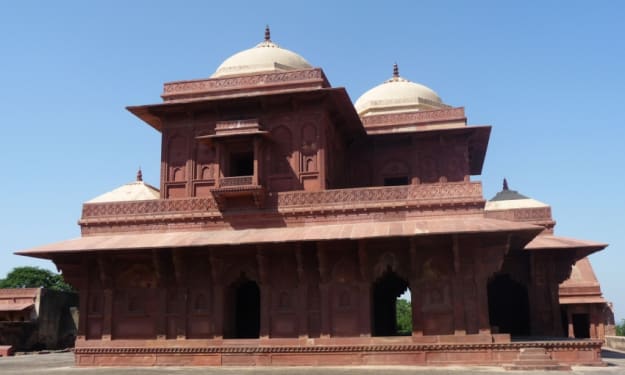
The sinhalese kingdom of Anuradhapura entered into a large scale military uprising due to King Mahinda Vth's disastrous economic organization around 982 AD.The Anuradhapura capital's army was mostly made up of tamil mercenaries brought from corammandel coast.In 882 CE the military uprising of aforementioned merceneries and subsequent civil war peaked forcing weak sinhala king to flee the capital to Rohana principality putting the capital Anuradhapura into a 11 year civil war and complete anarchy.The destruction of the central administration further failed the payments for tamil mercenaries which prompted them to side with chola empire leaving Anuradhapura guardless against the 993 Chola invasion.[25][26]
In 993, Rajaraja conquered Anuradhapura(Pihiti rata),Sri Lanka, which was renamed as Ila-mandalam in the Chola records.[22] The Chola army sacked Anuradhapura, and captured the northern half of Sri Lanka. The Cholas established a provincial capital at the military outpost of Polonnaruwa, naming it Jananathamangalam after a title of Rajaraja.[26] The Chola official Tali Kumaran erected a Shiva temple called Rajarajeshwara ("Lord of Rajaraja") in the town of Mahatirtha (modern Mantota), which was renamed Rajarajapura.[26]
Comparing Rajaraja's campaign to the invasion of Lanka by the legendary hero Rama, the Thiruvalangadu Plates states:[1]
"Rama built with the aid of monkeys, a causeway across the sea, and then with great difficulties defeated the king of Lanka by means of sharp edged arrows. But Rama was excelled by this king whose powerful army crossed the ocean by ships and burnt up the king of Lanka."
— Thiruvalangadu Copper Plates[1]
In 1017, Rajaraja's son Rajendra I completed the Chola conquest of Sri Lanka.[27] The Cholas controlled Sri Lanka until 1070, when Vijayabahu I defeated and expelled them.[28]
Chalukyan conflict
In 998 CE, Rajaraja captured the regions of Gangapadi, Nolambapadi and Tadigaipadi (present day Karnataka).[29] Raja Chola extinguished the Nolambas, who were the feudatories of Ganga while conquering and annexing Nolambapadi.[30] The conquered provinces were originally feudatories of the Rashtrakutas.[31][32] In 973 CE, the Rashtrakutas were defeated by the Western Chalukyas leading to direct conflict with Cholas.[33] An inscription of Irivabedanga Satyashraya from Dharwar describes him as a vassal of the Western Chalukyas and acknowledges the Chola onslaught.[34] In the same inscription, he accuses Rajendra of having arrived with a force of 955,000 and of having gone on rampage in Donuwara thereby blurring the moralities of war as laid out in the Dharmasastras.[35] Historians like James Heitzman and Wolfgang Schenkluhn conclude that this confrontation displayed the degree of animosity on a personal level between the rulers of the Chola and the Chalukya kingdoms drawing a parallel between the enmity between the Chalukyas of Badami and the Pallavas of Kanchi.[36][37]
By 1004 CE, the Gangavadi province was conquered by Rajaraja.[38] The Changalvas who ruled over the western part of the Gangavadi province and the Kongalvas who ruled over Kodagu were turned into vassals.[39] The Chola general Panchavan Maraya who defeated the Changalvas in the battle of Ponnasoge and distinguished himself in this affair was rewarded with Arkalgud Yelusuvira-7000 territory and the title Kshatriyasikhamani.[40] The Kongalvas, for the heroism of Manya, were rewarded with the estate of Malambi (Coorg) and the title Kshatriyasikhamani.[39] Vengi kingdom was ruled by Jata Choda Bhima of the Eastern Chalukyas dynasty.[33] Jata Choda Bhima was defeated by Rajaraja and Saktivarman was placed on the throne of Vengi as a viceroy of the Chola Dynasty.[33][41] After the withdrawal of the Chola army, Bhima captured Kanchi in 1001 CE. Rajaraja expelled and killed the Andhra king called Bhima before re-establishing Saktivarman I on the throne of Vengi again.[42] Rajaraja gave his daughter Kundavai in marriage to his next viceroy of Vengi Vimaladitya which brought about the union of the Chola Dynasty and the Eastern Chalukya Kingdom and which also ensured that the descendants of Rajaraja would rule the Eastern Chalukya kingdom in the future.[41]
Hoysala conflicts
There were encounters between the Cholas and the Hoysalas, who were vassals of the Western Chalukyas. An inscription from the Gopalakrishna temple at Narasipur dated to 1006 records that Rajaraja's general Aprameya killed minister Naganna and other generals of the Hoysalas.[43] A similar inscription in Channapatna also describes Rajaraja defeating the Hoysalas.[44]
Kalinga conquest
The invasion of the kingdom of Kalinga occurred after the conquest of Vengi.[45] It was an important conquest, marking the northern reaches of the Chola Empire at that time to rule the whole of South and South-East India
Conquest of Kuda-malai-nadu
There are multiple references to the conquest of "Kuda-malai-nadu" by king Rajaraja (from c. 1000 CE onwards).[8][46] The term Kudagu-malai-nadu is substituted in place of Kuda-malai-nadu in some of the inscriptions found in Karnataka and this region has been generally identified with Coorg (Kudagu).[8][47]
It is said that the king conquered Malainadu for the sake of messengers in one day after crossing 18 mountain passes (Vikrama Chola Ula).[8] Kulottunga Chola Ula makes reference to Rajaraja cutting off 18 heads and setting fire to Udagai.[21] Kalingathupparani mentions the institution of Chadaya Nalvizha in Udiyar Mandalam, the capture of Udagai, and the plunder of several elephants from there.[8] Tiruppalanam inscription (999 CE) mentions the gift of an idol by king from the booty obtained in Malainadu.[8][48][49][50]
Naval expedition
"A naval campaign led to the conquest of the Maldive Islands, the Malabar Coast, and northern Sri Lanka, all of which were essential to the Chola control over trade with Southeast Asia and with Arabia and eastern Africa. These were the transit areas, ports of call for the Arab traders and ships to Southeast Asia and China, which were the source of the valuable spices sold at a high profit to Europe."
— Romila Thapar, "Encyclopaedia Britannica".
One of the last conquests of Rajaraja was the naval conquest of the islands of Maldives ("the Ancient Islands of the Sea Numbering 1200").[51][8] The naval campaign was a demonstration of the Chola naval power in the Indian Ocean.[8]
The Cholas controlled the area around of Bay of Bengal with Nagapattinam as the main port. The Chola Navy also had played a major role in the invasion of Sri Lanka.[52] The success of Rajaraja allowed his son Rajendra Chola to lead the Chola invasion of Srivijaya, carrying out naval raids in South-East Asia and briefly occupying Kadaram.[5][53]
Personal life
Rajaraja married a number of women, including the following: Vanathi aka Thiripuvāna Mādēviyār, Dantisakti Vitanki aka Lokamadevi, Panchavan Madeviyar, Chola Mahadevi, Trailokya Mahadevi, Lata Mahadevi, Prithvi Mahadevi, Meenavan Mahadevi, Viranarayani and Villavan Mahadevi.[54][55][56][57] He had at least three daughters. He had two sons: the elder one is Rajendra with Thiripuvāna Mādēviyār[58][59][60] and younger one is Araiyan Rajarajan (Mother unknown).He had his first daughter Kundavai with Lokamadevi. Kundavai married Chalukya prince Vimaladithan. He had two other daughters named Mathevadigal[citation needed] and Ģangamādevi or Arumozhi Chandramalli.[57] Rajaraja died in 1014 CE in the Tamil month of Maka and was succeeded by Rajendra Chola I.[61]
About the Creator
karthik
Karthik is an accomplished content creator and copywriter with a passion for producing high-quality, engaging content that resonates with audiences. He has honed his skills through years of experience in the industry and is known





Comments
There are no comments for this story
Be the first to respond and start the conversation.